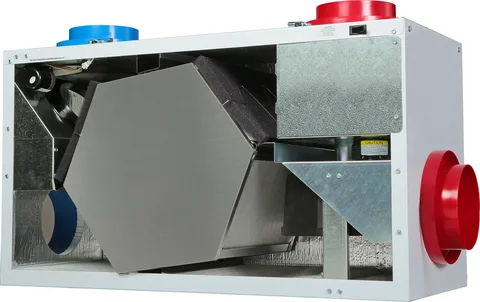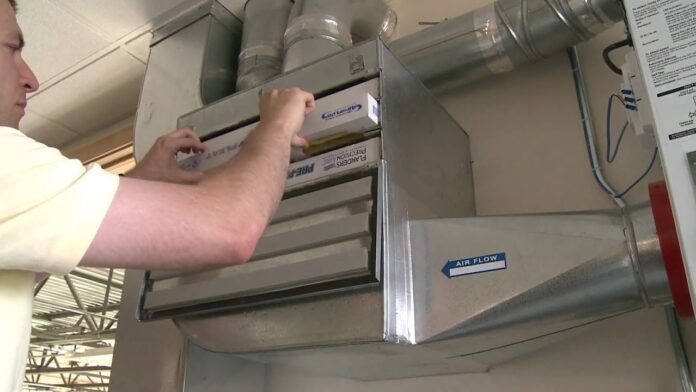Are you looking for an efficient and eco-friendly way to ventilate your home? Look no further than a Heat Recovery Ventilation System. This innovative technology improves indoor air quality, helps save energy and reduces heating costs. In this blog post, we’ll dive into how HRV works, its benefits, and why it’s the green way to ventilate your home. Let’s get started!
Understanding the Importance of Ventilation
Ventilation is a crucial aspect of maintaining a healthy and comfortable living environment. It’s not just about opening a window or turning on a fan. Proper ventilation ensures that indoor air quality remains fresh and clean, reducing the risk of allergens, pollutants, and moisture buildup.
Indoor air can become stale and stagnant without adequate ventilation, increasing mould, mildew, and unpleasant odours. It can also accumulate harmful substances such as volatile organic compounds (VOCs) and carbon dioxide (CO2). These pollutants can have a detrimental impact on our respiratory health and overall well-being.
Furthermore, poor ventilation can also contribute to the spread of airborne illnesses and respiratory infections. Adequate air circulation helps to dilute and remove airborne contaminants, reducing the risk of transmitting viruses and bacteria.
The Green Impact of Heat Recovery Ventilation (HRV) Systems
Heat recovery ventilation (HRV) systems are game-changers regarding being environmentally friendly. These innovative systems improve indoor air quality, save energy, and have a significant green impact.
By recovering heat from the exhaust air and preheating incoming fresh air, HRV systems reduce the energy needed to heat your home. This translates into lower heating costs and a reduced carbon footprint.
But the green benefits continue beyond there. HRV systems also help reduce the overall energy demand, reducing greenhouse gas emissions. By ensuring a continuous supply of fresh air while minimizing energy waste, HRV systems promote a sustainable and eco-friendly living environment.
 How Heat Recovery Ventilation (HRV) System Works
How Heat Recovery Ventilation (HRV) System Works
A heat recovery ventilation (HRV) system exchanges your home’s stale, polluted air with fresh, filtered outdoor air. It uses a heat exchanger to transfer heat from the outgoing air to the incoming air, ensuring that the temperature inside your home remains comfortable.
Here’s how it works:
- The HRV system consists of two fans – one that brings fresh air from outside and another that expels the stale air from inside.
- As the fans operate, the outgoing stale air passes through the heat exchanger, which extracts heat.
- Meanwhile, the incoming fresh air passes through a separate pathway and is heated by the extracted heat from the outgoing air.
- Thanks to the heat exchanger, the two air streams do not mix, ensuring that the stale air does not contaminate the fresh air.
- Finally, the fresh, preheated air is distributed throughout your home, while the stale air is expelled outside.
This continuous cycle of exchanging air helps maintain a clean and healthy indoor environment while minimizing energy waste. By recovering heat from the exhaust air, HRV systems significantly reduce the energy needed to heat the incoming air, resulting in energy savings and reduced heating costs.
In the next section, we’ll break down the components of an HRV and how each part contributes to its efficient operation.
Breaking Down the Heat Recovery Ventilator
The heat recovery ventilator (HRV) system comprises several key components that work together to ensure optimal ventilation and energy efficiency in your home. Let’s break down each part and understand its role in the HRV system:
Core
The core is the heart of the HRV system. It consists of a series of thin, alternating plates that separate the incoming and outgoing air streams. These plates allow heat to transfer from the warm air to the cooler air without mixing the two streams.
Fans
The HRV system has two fans – one for fresh outdoor air and another for expelling stale indoor air. These fans create the necessary airflow for ventilation and ensure a constant air exchange.
Filters
The HRV system has filters that capture dust, allergens, and other particles from the incoming air. These filters help improve indoor air quality by preventing pollutants from entering your home.
Controls
The controls of the HRV system allow you to adjust settings, such as fan speed and airflow direction. They also enable you to monitor the system’s performance and receive alerts for filter changes or maintenance requirements.
Ductwork
The ductwork in the HRV system connects the fans, filters, and core to distribute fresh air throughout your home and expel stale air outside. Properly designed and installed ductwork ensures efficient air circulation and prevents air leakage.
Understanding the different components of the HRV system is essential for ensuring its proper operation and maintenance. By working together, these components help create a healthy, comfortable, and energy-efficient living environment in your home.
Discovering the Energy-Recovery Ventilator
Have you heard about the energy-recovery ventilator (ERV)? It’s a fascinating alternative to the heat recovery ventilation (HRV) system we discussed earlier. While both systems serve the same purpose of providing fresh air and saving energy, the ERV has an additional feature that sets it apart.
The energy-recovery ventilator transfers heat from the outgoing stale air to the incoming fresh air and transfers moisture. This means that during the summer, when the outdoor air is more humid than the indoor air, the ERV will transfer moisture from the incoming air to the outgoing air, helping to reduce humidity levels inside your home. In the winter, when the indoor air is more humid, the ERV will transfer moisture from the outgoing air to the incoming air, preventing dryness.
Heat Recovery Vs. Energy Recovery Ventilators: Which Is Right For You?
Choosing the right ventilation system for your home can be daunting, especially when you’re faced with options like heat-recovery ventilators (HRVs) and Energy Recovery Ventilator (ERVs). Which one is right for you? Let’s break it down.
HRVs are ideal for climates where the temperature difference between the indoor and outdoor air is significant. They excel at transferring heat from the outgoing stale air to the incoming fresh air, helping you save on heating costs. However, HRVs don’t transfer moisture, so they may not be the best choice in a humid climate.
On the other hand, ERVs are designed to transfer both heat and moisture between the air streams. This makes them perfect for areas with high humidity levels. ERVs can help maintain optimal indoor humidity, preventing mould growth and dryness. However, they are less effective at heat recovery compared to HRVs.
Installing a Heat Recovery Ventilation (HRV) System: What You Need To Know?
Installing a Heat Recovery Ventilation (HRV) system in your home can greatly improve indoor air quality and reduce energy consumption. But before you start the installation process, you need to know a few key things.
- First, it’s important to assess your home’s specific ventilation needs. Consider factors such as the size of your home, the number of rooms, and the layout. This will help determine the size and capacity of the HRV system you’ll need.
- Next, you’ll want to find a reputable HVAC contractor specializing in HRV installations. They will have the expertise to size and install the system properly, ensuring optimal performance.
- During installation, the contractor must identify suitable locations for the HRV unit and the ductwork. Choosing strategic locations that allow for efficient air exchange throughout your home is crucial.
- Additionally, proper maintenance is key to keeping your HRV system running smoothly. This includes regular filter changes, cleaning the vents, and inspecting the fans and controls. Regular maintenance will ensure that your system operates effectively and efficiently for years.
Maintenance Tips for Your Heat Recovery Ventilation (HRV) System
Proper maintenance is crucial for keeping your heat recovery ventilation (HRV) system running smoothly and efficiently. By following these maintenance tips, you can ensure that your HRV system continues to provide fresh, clean air for years to come.
Regularly clean and replace filters
Filters in your HRV system trap dust, allergens, and other particles from the incoming air. Clean or replace these filters every 3 to 6 months to maintain optimal airflow and prevent a buildup of contaminants.
Clean the vents
Dust and debris can accumulate on the vents, hindering air circulation. Regularly wipe down the vents with a damp cloth or use a vacuum with a brush attachment to remove any dirt or dust.
Inspect the fans and controls
Check the fans and controls of your HRV system to ensure they are functioning properly. Contact a professional HVAC technician for inspection and repair if you notice any unusual noises or performance issues.
Monitor the humidity levels
Keep an eye on the humidity levels in your home. If you notice excessive moisture or condensation, adjust the settings on your HRV system or consider installing a dehumidifier to prevent mould growth and maintain a comfortable environment.
Schedule professional maintenance
While regular cleaning and inspection are important, scheduling professional maintenance at least once a year is also recommended. A qualified HVAC technician can thoroughly clean and service your HRV system, ensuring optimal performance and efficiency.
FAQ’s
You may still have questions about heat recovery ventilation (HRV) systems. We’ve compiled a list of five frequently asked questions to help clear up any confusion.
1. Are HRV systems suitable for all types of homes?
HRV systems can be installed in various homes, including single-family houses, apartments, and condominiums. They can be customized to meet the specific needs of your home and its ventilation requirements.
2. Will a Heat Recovery Ventilator increase my energy consumption?
No, a Heat Recovery Ventilator is designed to be energy-efficient. By recovering heat from the exhaust air, it reduces the amount of energy needed to heat the incoming fresh air. This can lead to energy savings and lower heating costs.
3. How often should I clean the filters in my HRV system?
It’s recommended to clean or replace the filters in your HRV system every 3 to 6 months. This helps maintain optimal airflow and prevents a buildup of contaminants in the system.
4. Can I install an HRV system or need a professional?
While some homeowners may have the skills to install an HRV system themselves, hiring a professional HVAC contractor is generally recommended. They have the expertise and knowledge to size and install the system properly, ensuring optimal performance.
5. Can an HRV system help reduce odours in my home?
An HRV system can help reduce stale air in your home by exchanging stale air with fresh outdoor air. This helps eliminate unpleasant smells and keeps the indoor air fresh and clean.
Conclusion
Incorporating a heat recovery ventilation (HRV) system into your home is a smart and eco-friendly choice. Not only does it improve indoor air quality, but it also helps save energy and reduce heating costs. HRV systems create a healthy and comfortable living environment while minimizing energy waste by continuously exchanging stale air with fresh, preheated air. Whether you choose an HRV or an energy-recovery ventilator (ERV), both options offer significant benefits. So, make the green choice and consider investing in your home’s heat recovery ventilation system. Breathe easy and enjoy the eco-friendly benefits!

